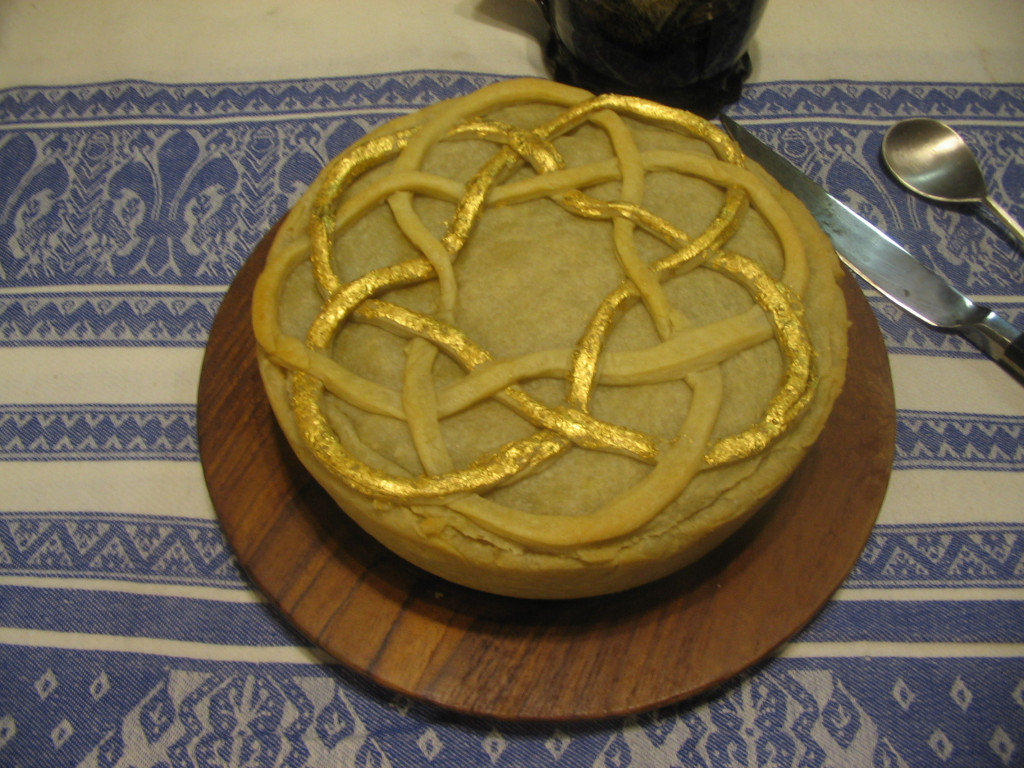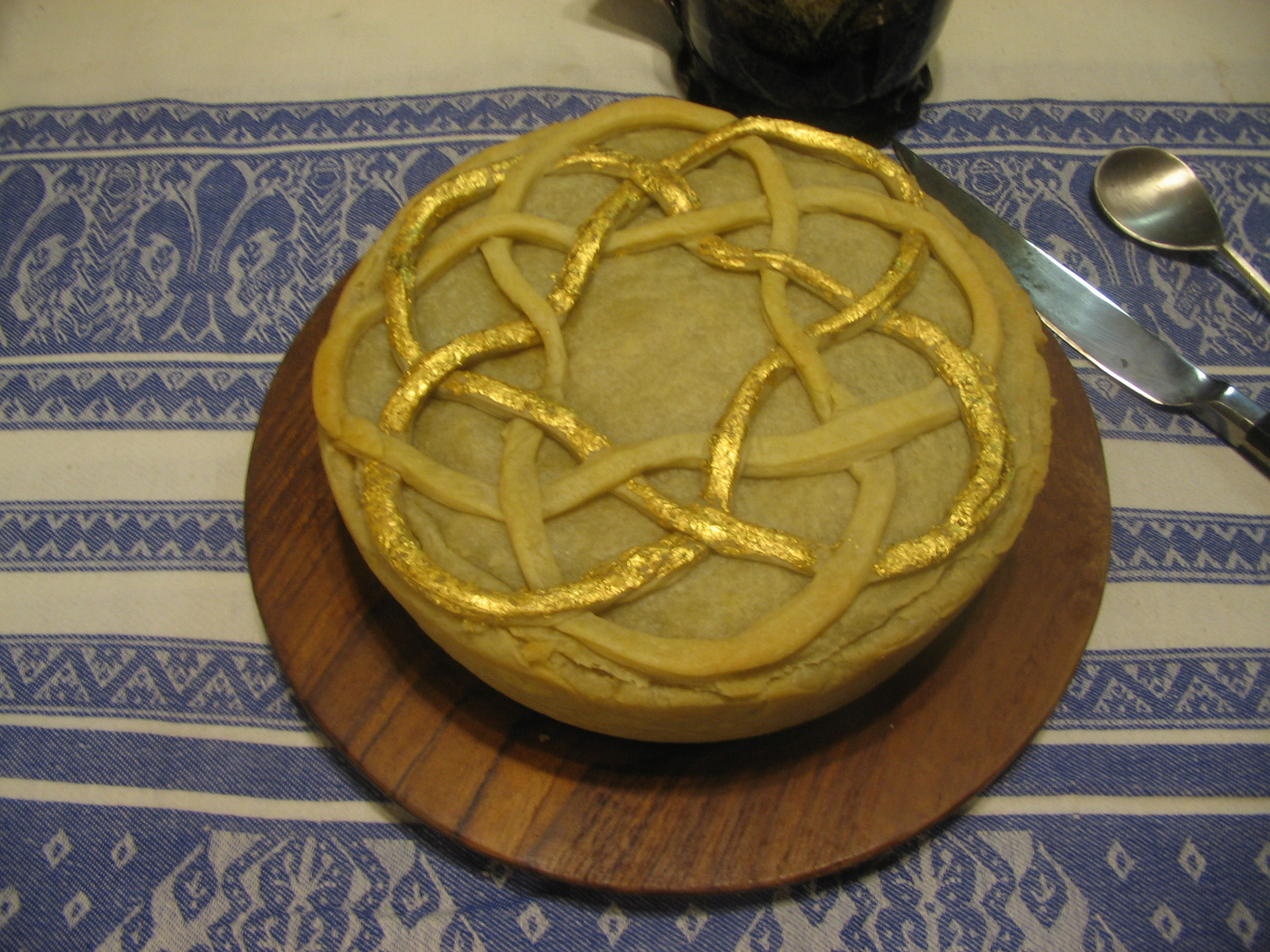Introduction
The Canton of Nimenefeld held an annual event, Cattle Raids (now Midnight at the Oasis / Camel Raids), at which one of the competitions was “Best Celtic Use of a Cow”. This pie was entered at Celtic Cattle Raids 4, and ended up winning this category.I hadn’t originally intended to enter this competition, which is why the documentation for this entry was a little shorter than usual; however, inspiration struck two nights before the event.

Original Recipes
To make a pastry dough for all shaped pies Take flour, the best that you can get, about two handfuls, depending on how large or small you would have the pie. Put it on the table and with a knife stir in two eggs and a little salt. Put water in a small pan and a piece of fat the size of two good eggs, let it all dissolve together and boil. Afterwards pour it on the flour on the table and make a strong dough and work it well, however you feel is right. If it is summer, one must take meat broth instead of water and in the place of the fat the skimmings from the broth. When the dough is kneaded, then make of it a round ball and draw it out well on the sides with the fingers or with a rolling pin, so that in the middle a raised area remains, then let it chill in the cold. Afterwards shape the dough as I have pointed out to you. Also reserve dough for the cover and roll it out into a cover and take water and spread it over the top of the cover and the top of the formed pastry shell and join it together well with the fingers. Leave a small hole. And see that it is pressed together well, so that it does not come open. Blow in the small hole which you have left, then the cover will lift itself up. Then quickly press the hole closed. Afterwards put it in the oven. Sprinkle flour in the dish beforehand. Take care that the oven is properly heated, then it will be a pretty pastry. The dough for all shaped pastries is made in this manner. – Sabina Welserin
Take & cut good pieces of pork, and pieces of veal, together, & put in a good pot, & add fresh broth, & a quantity of wine, & bring to a boil until done; than take it from the fire, & let it cool a little; than add egg yolks, & ginger, sugar, & salt, & minced dates, & currants; then make good pastry, then pie shells, and add; cover the pie, and bake it, and serve.- Pies of Paris. Two Fifteenth-Century Cookery-Books. Harleian MS. 279 & Harl. MS. 4016
Pyes of mutton or beif must be fyne mynced and ceasoned wyth pepper and salte, and a lyttle saffron to coloure it, suet or marrow a good quantite, a lyttle vyneger, prumes, greate raysins, and dates, take the fattest of the broathe of powdred beyfe, and yf you wyll haue paest royall, take butter and yolkes of egges, and to tempre the flowre to make the paeste. A Proper newe Booke of Cokerye
Discussion
I was not able to find any specifically “Celtic” beef recipes (or Celtic recipes at all!). However, there are a large variety of meat pies in the medieval corpus, in all cultures and time periods, so the assumption that this type of dish dates back as far as the Celts is not unreasonable, especially as “meat wrapped in dough” recipes date back at least as early as the 12th century “Icelandic” cookbook.
These pies usually include either beef, veal, or pork, often with the addition of various dried fruits, spices, and eggs, sometimes with the addition of nuts or poultry. Sometimes the meat is cooked (usually by boiling) before placing in the pie, sometimes it is not. In almost all cases, the addition of fat is specified if the meat itself is not fatty. Instead of following a specific recipe for this pie, I chose elements of several pies to create a tasty dish – all of these pies are similar enough that this sort of “mix and match” is not unreasonable.
My only evidence for pastry decorations such as this is Elizabethan; but knotwork was at least described as being used. This particular design was chosen merely to fit the theme of the competition.
Gilded Beef Pie
Ingredients
- Pastry
Flour
3 eggs
1.5 stick of butter
water
- Filling
2 lbs beef chuck roast
Beef broth
Currents
Egg Yolks
Assorted spices: salt, sugar, ginger, grains of paradise, saffron
Directions
- Begin by chopping 2 pounds of beef chuck roast finely, including the fatty portions of the meat.
- Boil the beef in broth until done, then drain the cooked meat.
- Add currents, salt, sugar, ginger, grains of paradise, and saffron to taste.
- Use some of the broth to temper egg yolks, then add to mixture to thicken. Set aside.
- Melted 1.5 sticks of butter with an equal amount of water.
- While this melts and comes to a boil, mix 3 egg yolks with enough flour to make a pie crust.
- Added the hot water/butter mixture and knead.
- Divide the pie crust into 3 parts, one slightly larger than the others.
- Roll out the largest piece and press into pie pan – a 14th-century replica ceramic pie dish is ideal of course, but metal or glass will work.
- Place the meat mixture into the pie.
- Roll out a second piece of pastry, and place over the meat.
- Seal the coffyn careful, and use remaining pie crust to create a “Celtic” knotwork pattern on top of the pie.
- Bake at 350 until pastry is golden brown.
- Use egg white and gold leaf on hot pie to gild.
